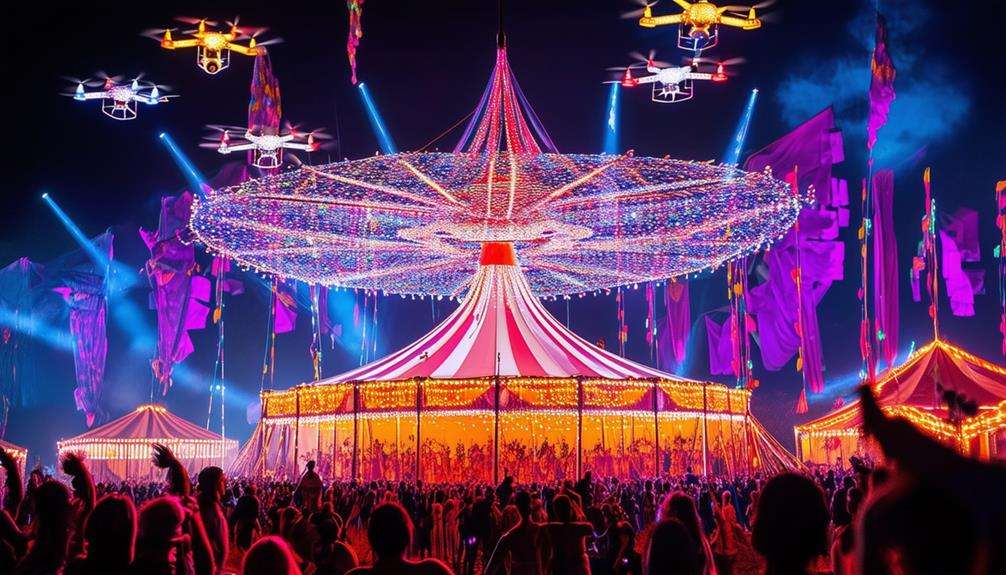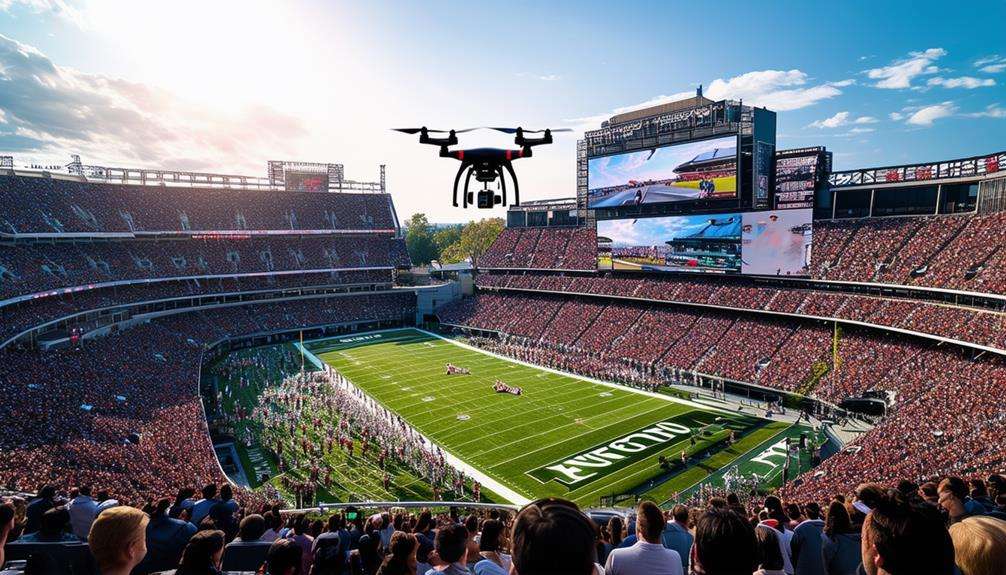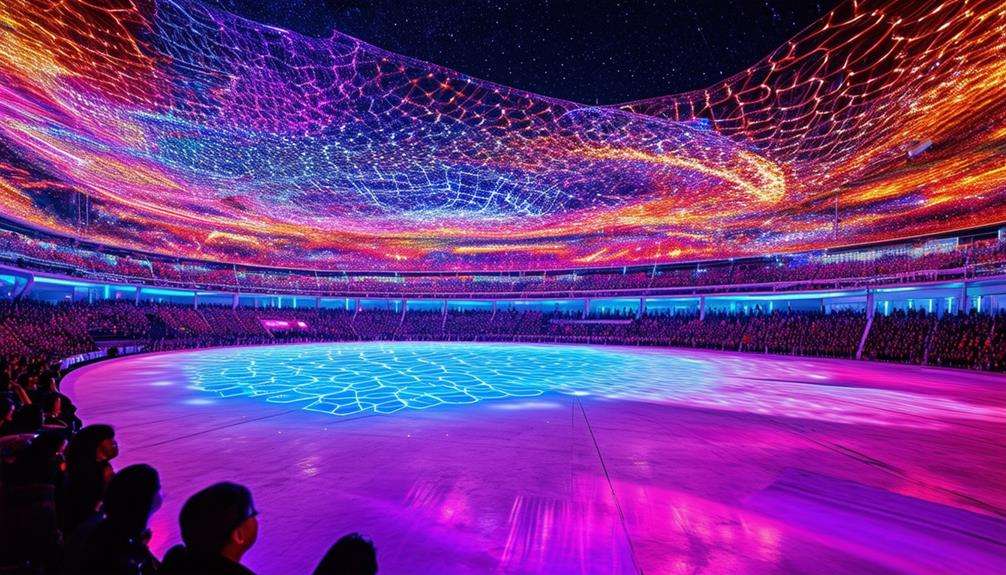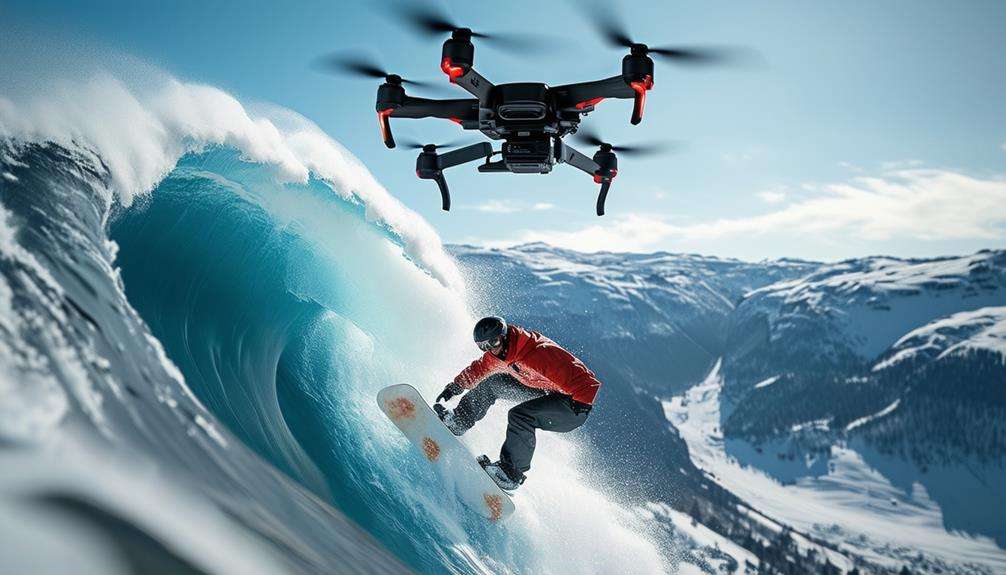How Drones Are Revolutionizing Film and Television Production
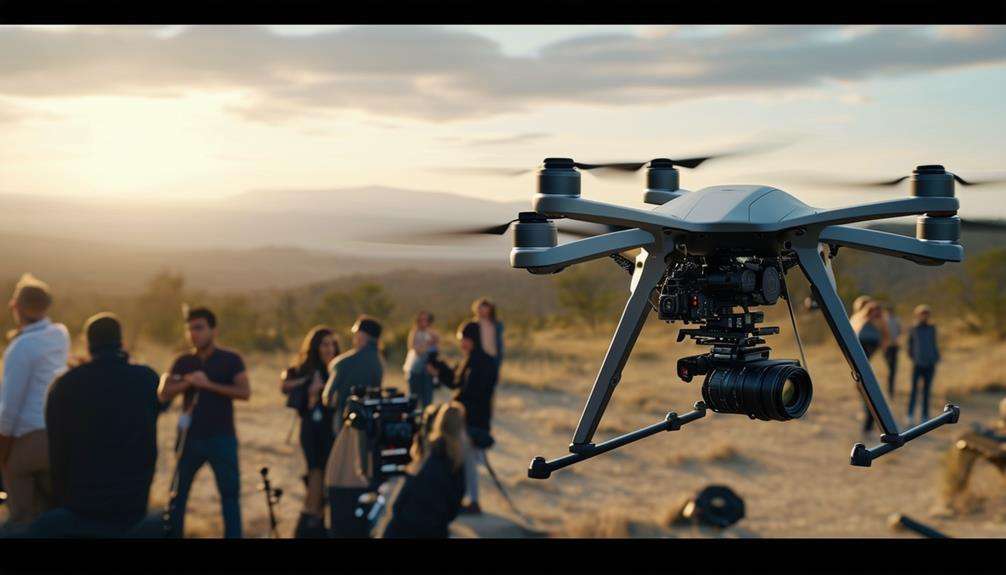
Imagine you're on a film set, and instead of relying on a costly helicopter, a drone is capturing breathtaking aerial shots. Drones have revolutionized film and television production, making it more cost-effective and versatile.
They provide filmmakers with advanced camera capabilities and unprecedented creative freedom, allowing for dynamic movements and navigation through tight spaces that traditional equipment can't manage.
But how exactly do these devices streamline production workflows and enrich storytelling? And what challenges and limitations do they bring? Let's explore how drones are reshaping the landscape of visual storytelling.
The Rise of Drone Technology
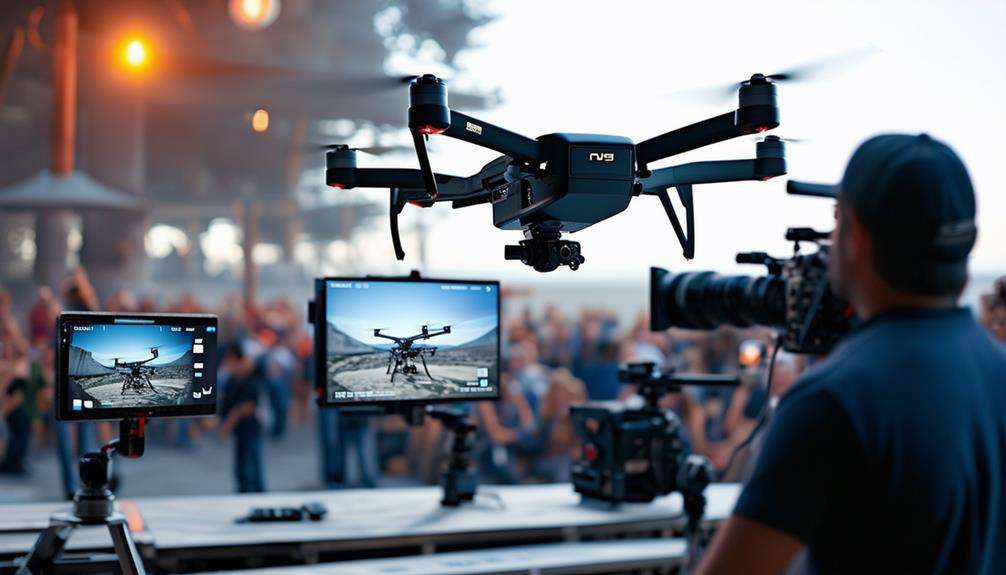
In the early 2010s, drone technology began to revolutionize film and TV production, offering filmmakers new possibilities for capturing stunning aerial shots. Hollywood's adoption of drones, seen in films like James Bond's Skyfall (2012), marked the beginning of a new era in cinematography. These unmanned aerial vehicles (UAVs) allowed for dynamic camera movements and unique angles that were previously challenging or impossible to achieve.
Drones provided a fresh perspective on visual storytelling, transforming the way scenes were captured. They enabled filmmakers to create high-impact aerial shots without the prohibitive costs and logistical challenges of traditional methods like helicopters or cranes. Imagine smoothly gliding over landscapes, swooping down city streets, or circling around characters during dramatic moments—all with unprecedented ease and precision.
The evolution of drone technology didn't stop at capturing beautiful footage; it fundamentally changed the film industry. Filmmakers now had a cost-effective, efficient tool to enhance the quality of their cinematography. As a result, drones opened up new avenues for storytelling, making it possible to achieve breathtaking visuals that captivate audiences.
Benefits of Drones in Filmmaking
Drones offer filmmakers a versatile and cost-effective means to capture stunning aerial shots, revolutionizing visual storytelling. Traditional methods like helicopters and cranes aren't only expensive but also cumbersome, whereas drone cinematography significantly reduces these costs while delivering high-quality footage. Equipped with advanced cameras and stabilizing gimbals, drones enable the capture of dynamic and unique shots from various heights and angles that were once either impossible or prohibitively expensive.
The capacity to capture breathtaking aerial shots with drones doesn't just save money; it significantly enhances storytelling. Aerial perspectives can add depth, emotion, and visual interest, making scenes more engaging and immersive. Moreover, using drones simplifies the process of obtaining aerial footage. There's no need to coordinate with pilots or undergo extensive setups, saving both time and effort.
While safety protocols are crucial, modern drones come with features that enhance safety and ease of use. This allows filmmakers to focus more on their creative vision and less on potential risks. Drones offer creative freedom and versatility, enabling experimentation with different visual styles and angles to captivate audiences.
Capturing Aerial Shots
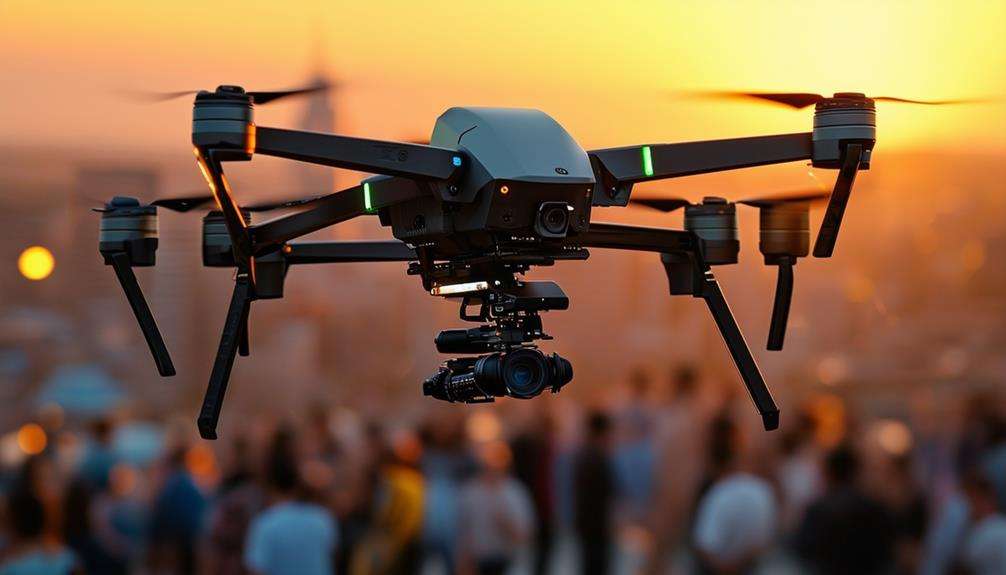
How can filmmakers capture awe-inspiring aerial shots that elevate their storytelling to new heights? Drones have revolutionized the way filmmakers approach aerial cinematography. No longer dependent on expensive helicopter rentals or cumbersome crane setups, filmmakers can now achieve stunning aerial views with remarkable ease and at a fraction of the cost.
Drones offer unparalleled maneuverability, enabling dynamic and gripping shots that add depth and scale to any project. Filmmakers can position drones creatively to capture unique angles, enriching visual narratives and immersing audiences more deeply into the story.
Furthermore, drones provide incredible flexibility. They can navigate tight spaces, fly at low altitudes, and follow subjects with precision, making them ideal for dynamic action sequences. This adaptability allows filmmakers to capture shots that were previously impossible or too risky to attempt.
The efficiency of drones also saves time and effort, allowing for quick deployment and adaptability to changing circumstances. This means filmmakers can focus more on their creative vision and less on logistical challenges, making the process of capturing aerial shots both faster and more efficient.
Enhancing Cinematography
Embracing drone technology can significantly enhance your cinematography by offering innovative perspectives and dynamic camera movements. Drones have transformed the way filmmakers capture aerial footage, providing stunning views that were once only attainable with costly helicopter rentals. With a drone, you can achieve versatile shooting styles and unique camera angles that elevate your storytelling.
One of the standout features of drones in cinematography is their maneuverability. They allow for precise subject tracking, intricate aerial maneuvers, and engaging visual sequences that would otherwise be difficult to film. This flexibility not only expands your creative possibilities but also improves production efficiency by reducing setup time.
Key Benefits of Using Drones in Cinematography:
| Benefit | Description |
|---|---|
| Cost-Effective | Eliminates the need for expensive helicopter rentals |
| Versatile Shooting | Offers a variety of creative perspectives and dynamic camera movements |
| Precise Subject Tracking | Enables accurate and smooth tracking of moving subjects |
| Expanded Creativity | Facilitates unique camera angles and innovative shots |
| Increased Efficiency | Saves time on setup, enhancing overall production efficiency |
Popular Drone Models
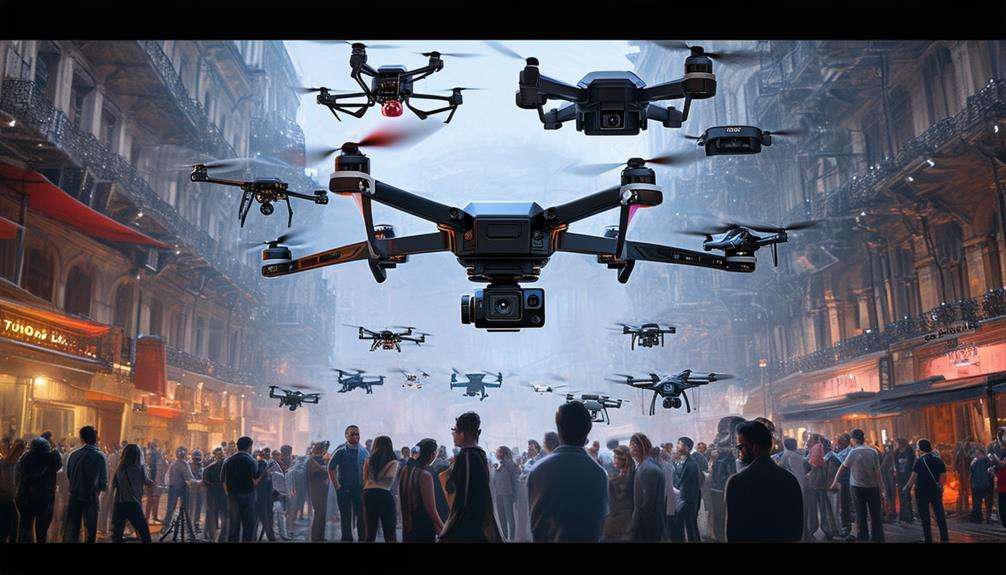
To enhance your filmmaking with the unique perspectives drones provide, let's explore some of the most popular models favored by professionals. The DJI Inspire 2 is a top choice, known for its professional-grade camera system and exceptional flight performance. Its advanced features enable the capture of stunning, high-resolution footage, making it a favorite among serious filmmakers.
Another excellent option is the DJI Mavic 2 Pro, equipped with a Hasselblad camera renowned for its superior image quality. This model is particularly valued in the industry for producing high-quality film images, allowing you to capture detailed and vibrant shots effortlessly.
For those prioritizing portability, the Mavic Air 2 is an ideal choice. Its compact design doesn't compromise performance, offering versatility and outstanding image quality in a smaller package. This makes it perfect for on-the-go filmmakers needing a reliable, easy-to-carry drone.
Techniques in Drone Use
In film and television, drones are used to capture stunning visuals through various techniques. Aerial shots provide breathtaking views, seamless transitions enhance scene fluidity, and dynamic action sequences add energy. These methods are revolutionizing storytelling on screen.
Aerial Cinematic Shots
Drones have revolutionized aerial cinematography, enabling filmmakers to capture breathtaking visuals with unparalleled precision and creativity. These devices facilitate stunning aerial shots that were once achievable only through costly helicopter rentals or cumbersome crane setups. Now, you can enrich storytelling by adding depth and scale to your scenes via creative camera positioning using drones.
Their maneuverability opens up a world of creative possibilities, allowing you to capture dynamic tracking shots, sweeping panoramic views, and unique angles that were previously impractical. Imagine following a car chase from above, gliding smoothly over a landscape, or diving dramatically down a cliff—all with a single device. This versatility enhances the cinematic experience, making projects more engaging for viewers.
Furthermore, drones offer the freedom to experiment with different visual styles. Whether filming an intense action sequence or a serene landscape, the ability to change perspectives quickly can significantly improve creative output.
Seamless Scene Transitions
Harnessing the creative potential of aerial shots, drones can facilitate smooth scene transitions that maintain narrative flow and captivate your audience. Drones excel in moving seamlessly between different locations or perspectives, ensuring continuity without jarring interruptions.
One effective technique is dynamic fly-through shots. These shots allow the drone to transport viewers smoothly from one setting to another, creating a fluid narrative progression. Imagine transitioning from an indoor scene to an expansive outdoor landscape in one continuous shot. This not only keeps the audience engaged but also adds sophistication to your production.
Visually captivating shifts are another strength of drones. Leveraging drone technology, you can create immersive changes that draw viewers deeper into the story. These fluid and cohesive shifts enhance the overall viewing experience, making the storytelling more compelling and visually appealing. Incorporating drones for seamless scene changes ensures your production stands out, keeping your audience enthralled from start to finish.
Dynamic Action Sequences
Imagine a high-speed chase where the camera swoops and dives, capturing every thrilling moment from breathtaking angles. Drones bring unparalleled dynamism to action sequences in film and television. With precise tracking and fast-paced movements, drones can capture scenes that would be nearly impossible with traditional cameras. Techniques like orbit shots around characters, high-speed tracking shots during chase scenes, and close-up aerial footage all amplify the intensity and immersion of these sequences.
Drones enable smooth transitions between characters, locations, and action moments, making scenes feel fluid and uninterrupted. The intricate aerial maneuvers possible with drone technology allow for filming adrenaline-pumping stunts and dynamic motion sequences from unique angles, offering fresh perspectives that keep audiences engaged and on the edge of their seats.
Challenges and Limitations
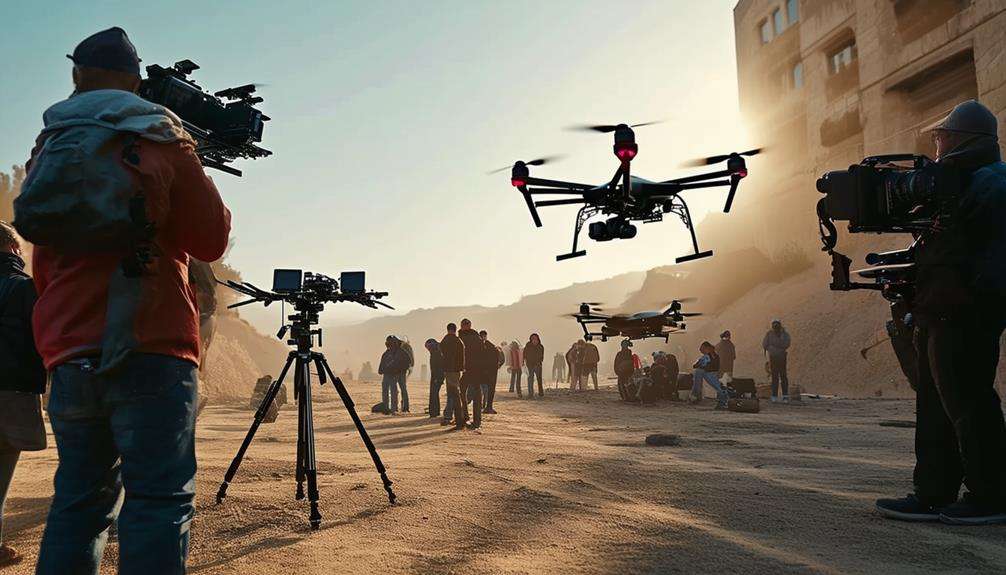
Filming with drones presents a unique set of challenges, ranging from unpredictable weather to intricate legal regulations. Safety is paramount; it's crucial to ensure that drone operations don't compromise anyone's well-being. Variables like wind, rain, and extreme temperatures can significantly affect flight stability and footage quality. Anticipating these factors is essential to prevent disruptions during shooting.
Efficiently managing flight times is another critical aspect. Drones generally have limited battery life, necessitating meticulous planning to optimize shot efficiency. Running out of battery mid-flight can result in mid-air emergencies, potentially leading to the loss of the drone or valuable footage. Always keep spare batteries available and plan for regular battery swaps to maintain continuous filming sessions.
Despite technological advancements, drones aren't infallible. Technical failures can occur, often at inconvenient moments. Proper planning and contingency measures can mitigate these risks. Conduct thorough risk assessments before each flight and ensure your team is well-trained to minimize potential accidents. These challenges make drone filming a complex yet rewarding endeavor.
Legal and Safety Considerations
When using drones in film and TV production, it's crucial to comply with aviation authority regulations and secure necessary permits. Adhering to safety guidelines and conducting regular maintenance checks ensures smooth operation and reduces the risk of accidents. Additionally, understanding privacy laws and airspace restrictions is essential to avoid legal issues.
Regulatory Compliance Requirements
Ensuring regulatory compliance is crucial for filmmakers using drones. This involves obtaining necessary permits and adhering to aviation guidelines set by authorities like the FAA in the US. Compliance includes rules on altitude, distance, and flight paths, emphasizing both safety and legal aspects.
For safety, you must ensure the well-being of your crew and the public. This involves using licensed pilots, conducting regular equipment maintenance, and implementing strict safety protocols on set.
Legal compliance requires obtaining location permits, securing insurance for drone operations, and understanding regulations for flying in controlled or restricted airspace. Additionally, understanding privacy laws and data protection regulations is essential. Violating airspace restrictions or compromising public safety can result in significant fines.
Adhering to these requirements mitigates risks, ensures smooth production processes, and maintains your positive reputation within the industry. By prioritizing safety and legal compliance, you can effectively utilize drones to enhance your film and television projects.
Ensuring Operational Safety
To ensure both legal compliance and the highest safety standards in drone usage for film and television production, stringent operational safety measures are essential. First, ensure that your drone pilots are trained and certified to minimize the risk of on-set accidents and guarantee professional operations. Legal compliance involves not only flying a drone but also obtaining necessary permits from aviation authorities and adhering to guidelines on altitude and distance.
Regular maintenance checks on your drones are crucial to prevent technical malfunctions that could disrupt filming or cause accidents. A thorough safety protocol should be implemented so that everyone on set is aware of the risks and knows how to mitigate them. Compliance with airspace regulations, privacy laws, and insurance requirements is also mandatory. Failure to adhere to these can result in hefty fines or legal action, jeopardizing your production.
Case Studies in Film Production
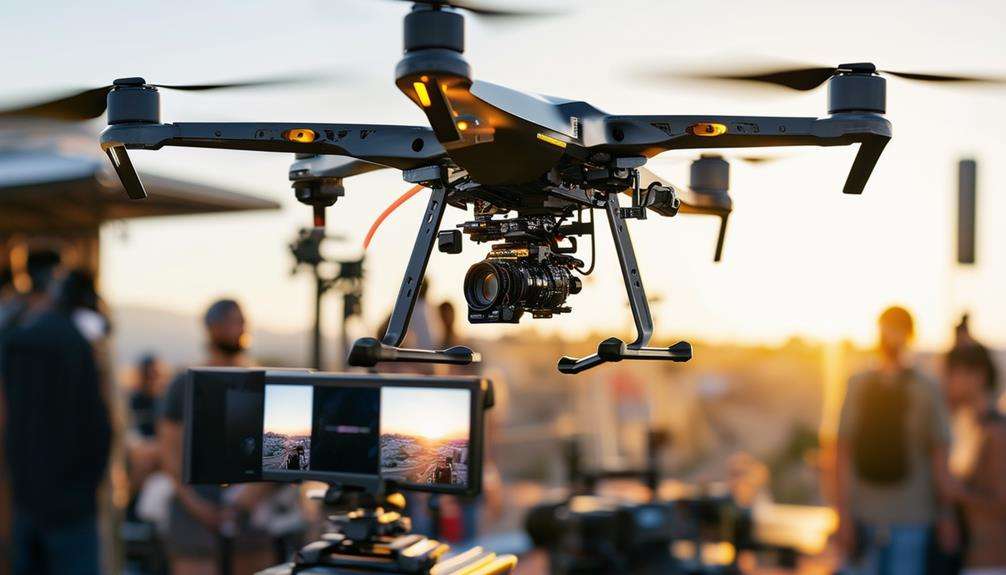
In 'Skyfall' (2012), drone cinematography demonstrated the groundbreaking potential of UAV technology in film production. Filmmakers used drones to capture stunning aerial shots, adding a new dimension to the movie's action sequences and opening up exciting possibilities for innovation.
Similarly, 'The Lord of the Rings' series employed drones to revolutionize epic fantasy filmmaking. The sweeping aerial views of Middle-earth captivated audiences and would have been challenging, if not impossible, to achieve with traditional methods.
The hit TV series 'Game of Thrones' also adopted drone technology for its dynamic aerial sequences. This significantly improved the show's visual storytelling, offering viewers a more immersive experience of Westeros.
Indie films have benefited as well. For instance, 'Tangerine' utilized drones for cost-effective aerial filming, proving that impressive aerial shots don't require a massive budget. This has made high-quality cinematography more accessible to emerging filmmakers. Lastly, in 'Jurassic World,' drones were crucial in capturing breathtaking aerial views of the dinosaur park, showcasing their versatility in blockbuster filmmaking.
Conclusion
In film and television production, the impact of drones is transformative. They enable the capture of breathtaking aerial shots, streamline workflows, and expand creative possibilities. Despite challenges and legal considerations, the advantages are clear. By adopting drone technology, filmmakers can create visually stunning and engaging stories like never before. This game-changing tool is essential for contemporary filmmaking.

